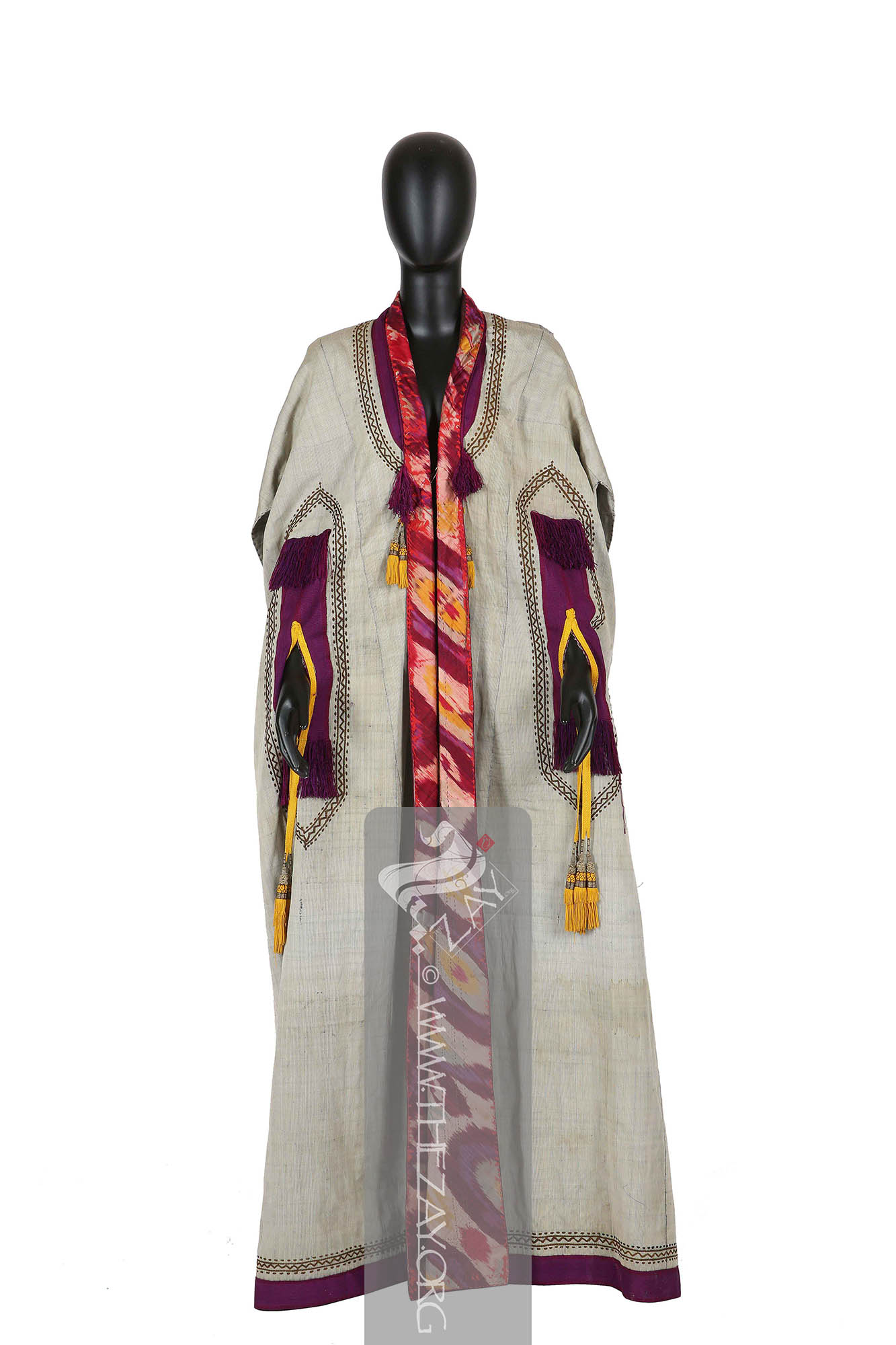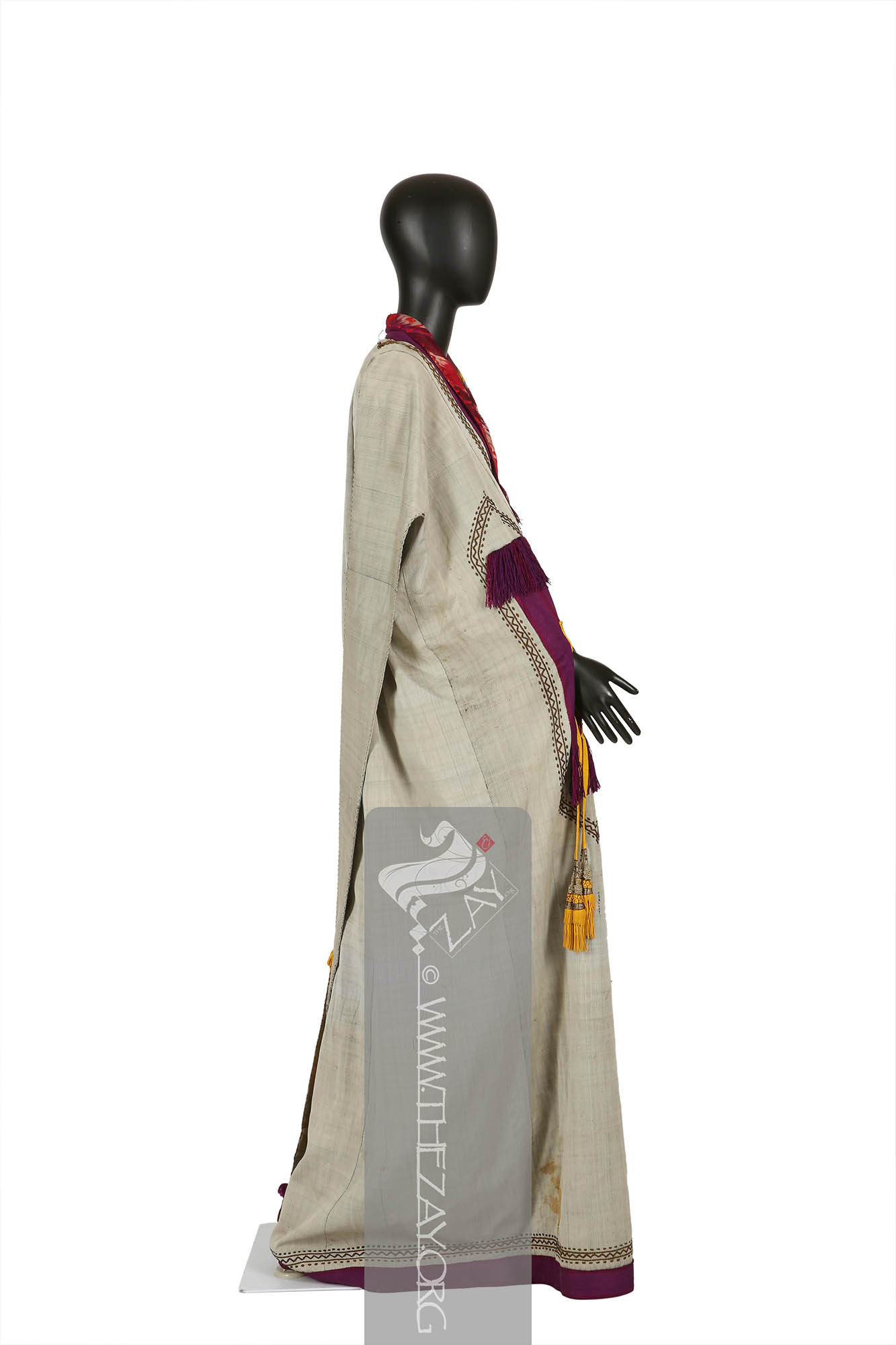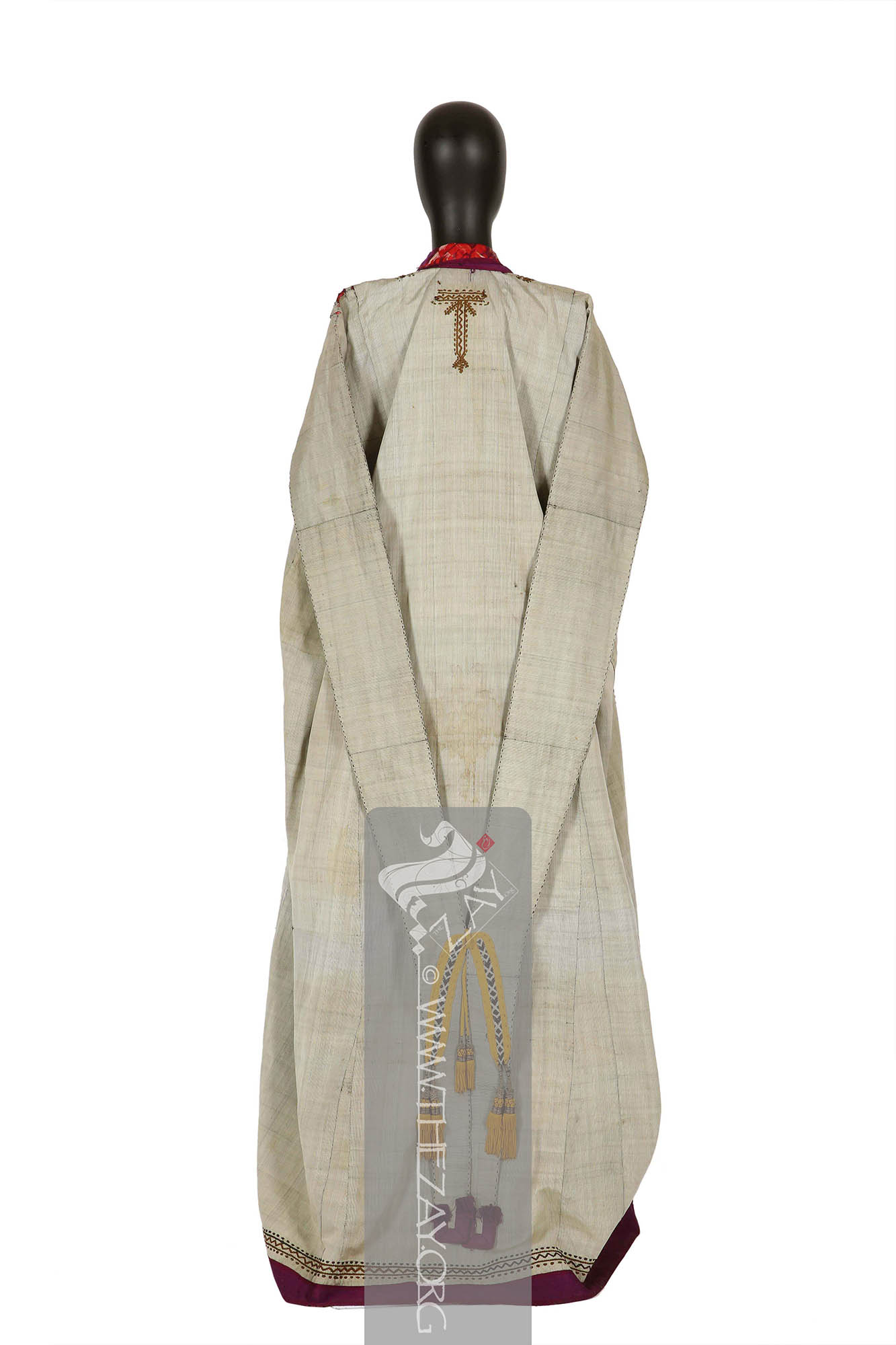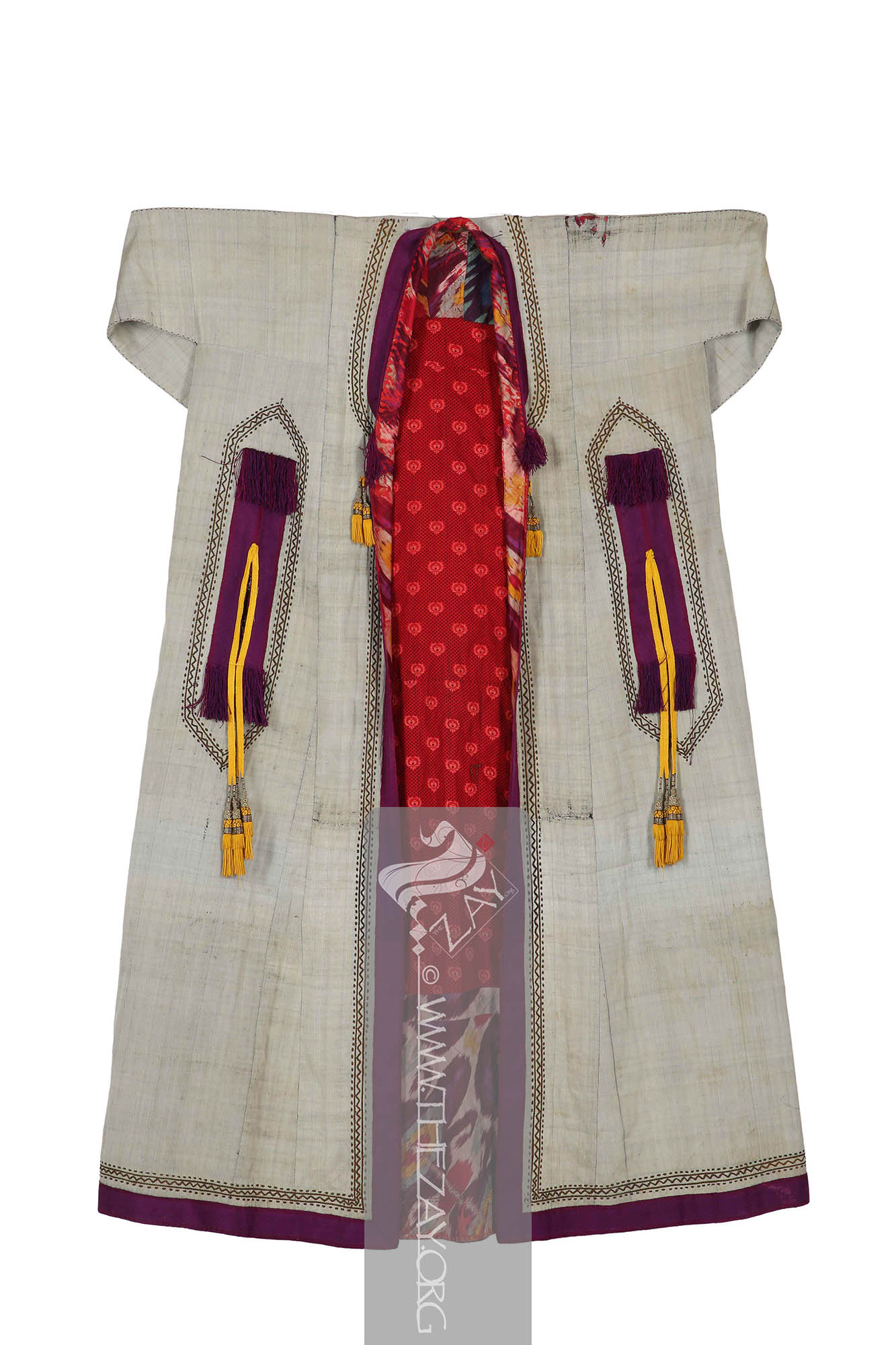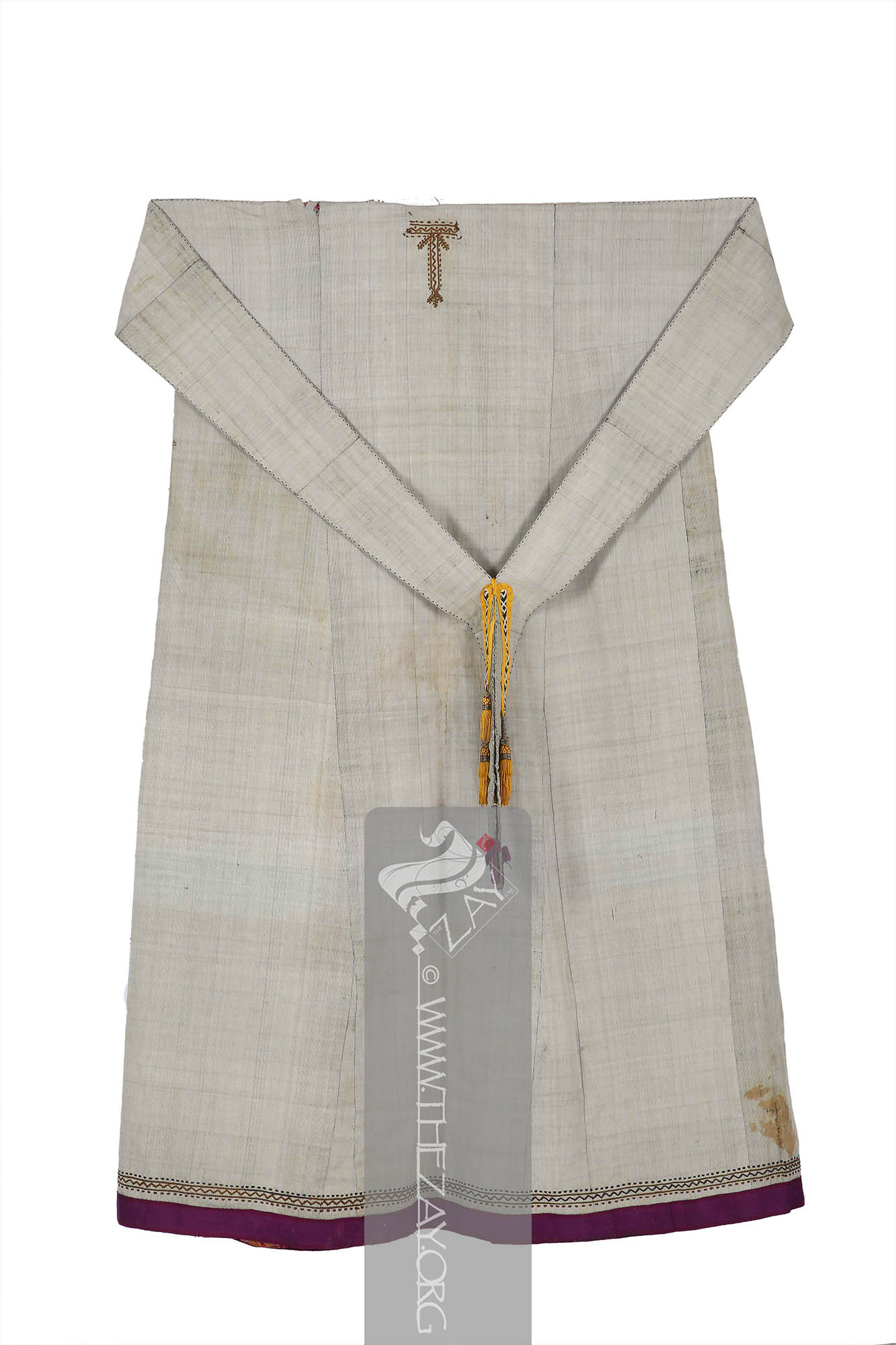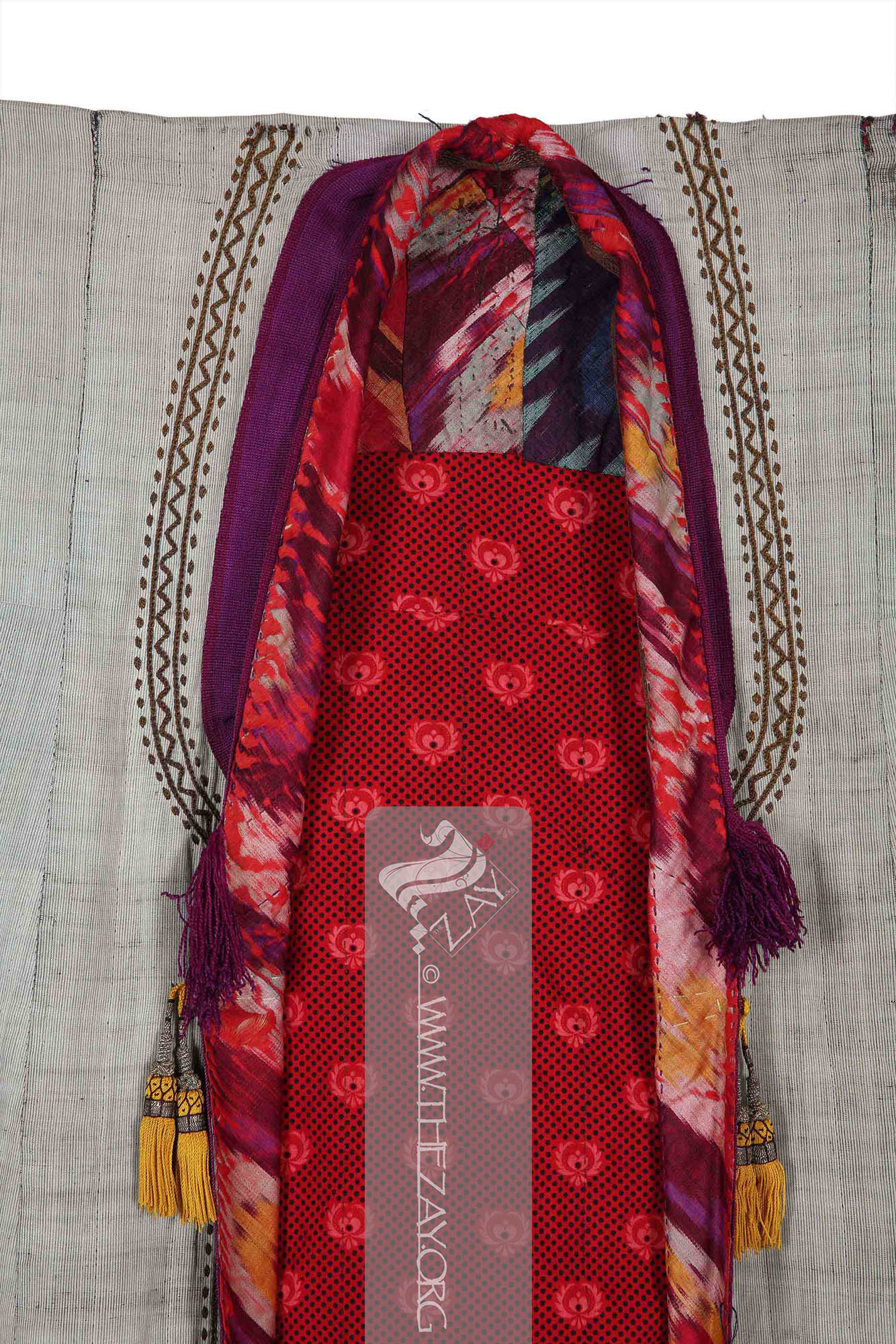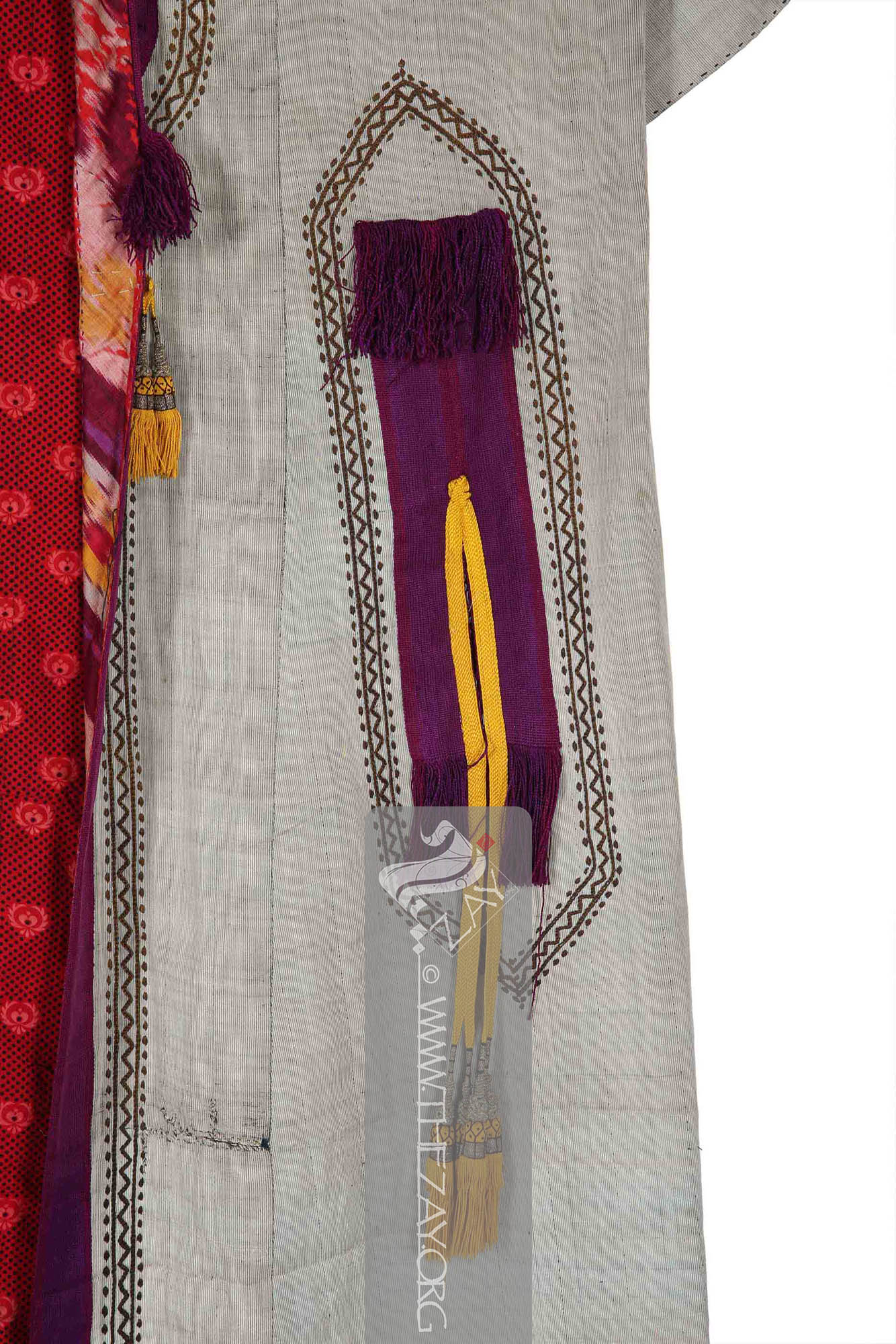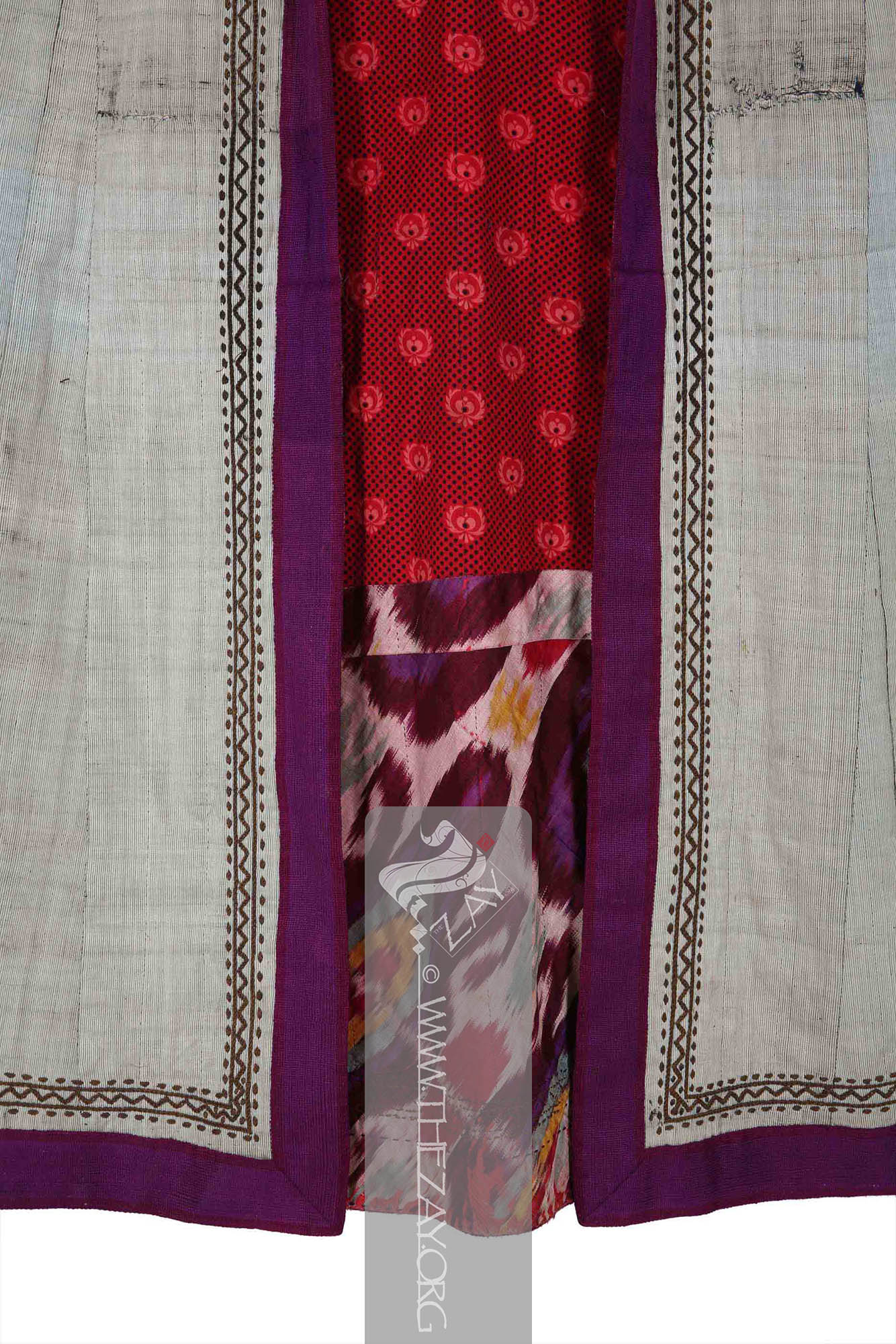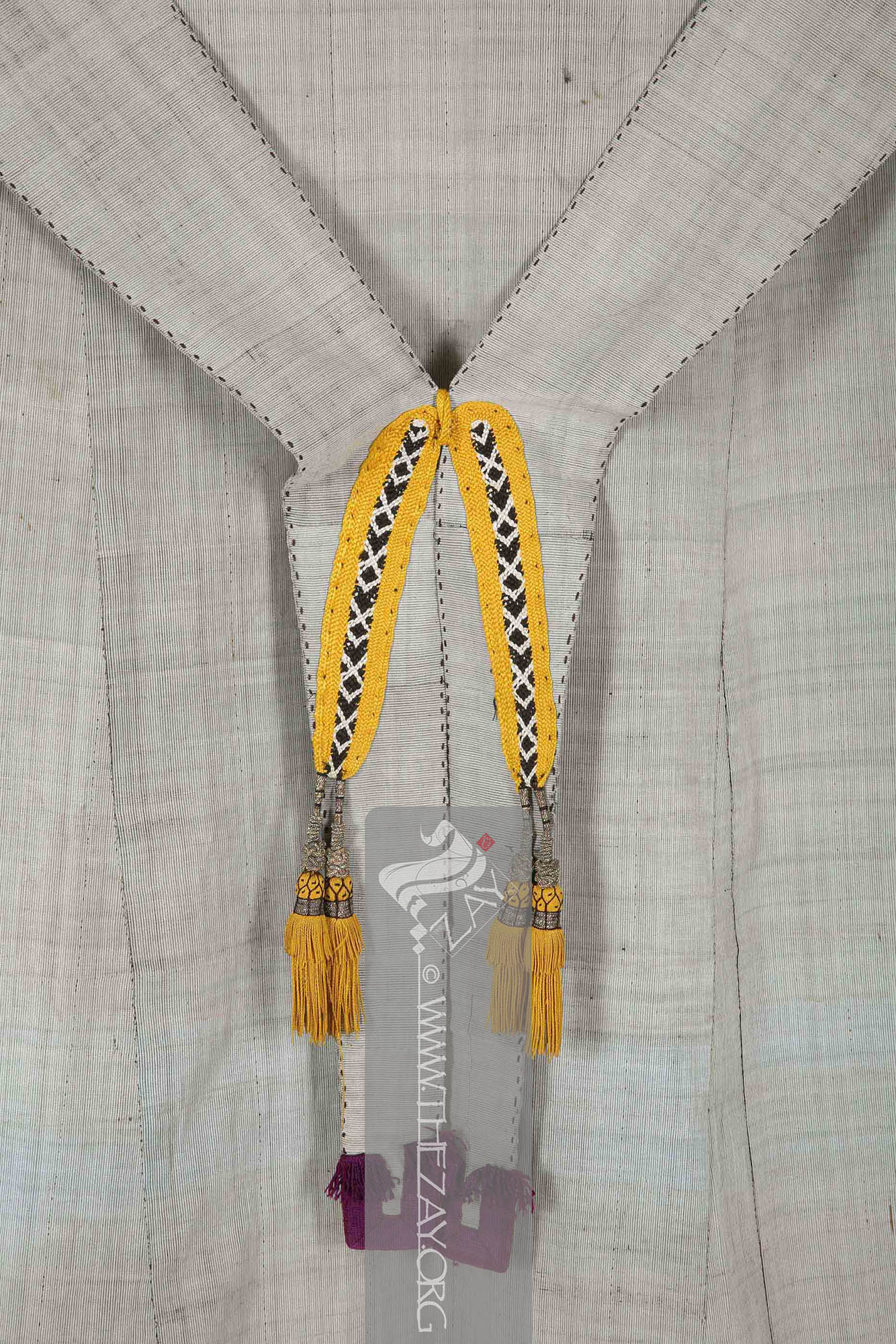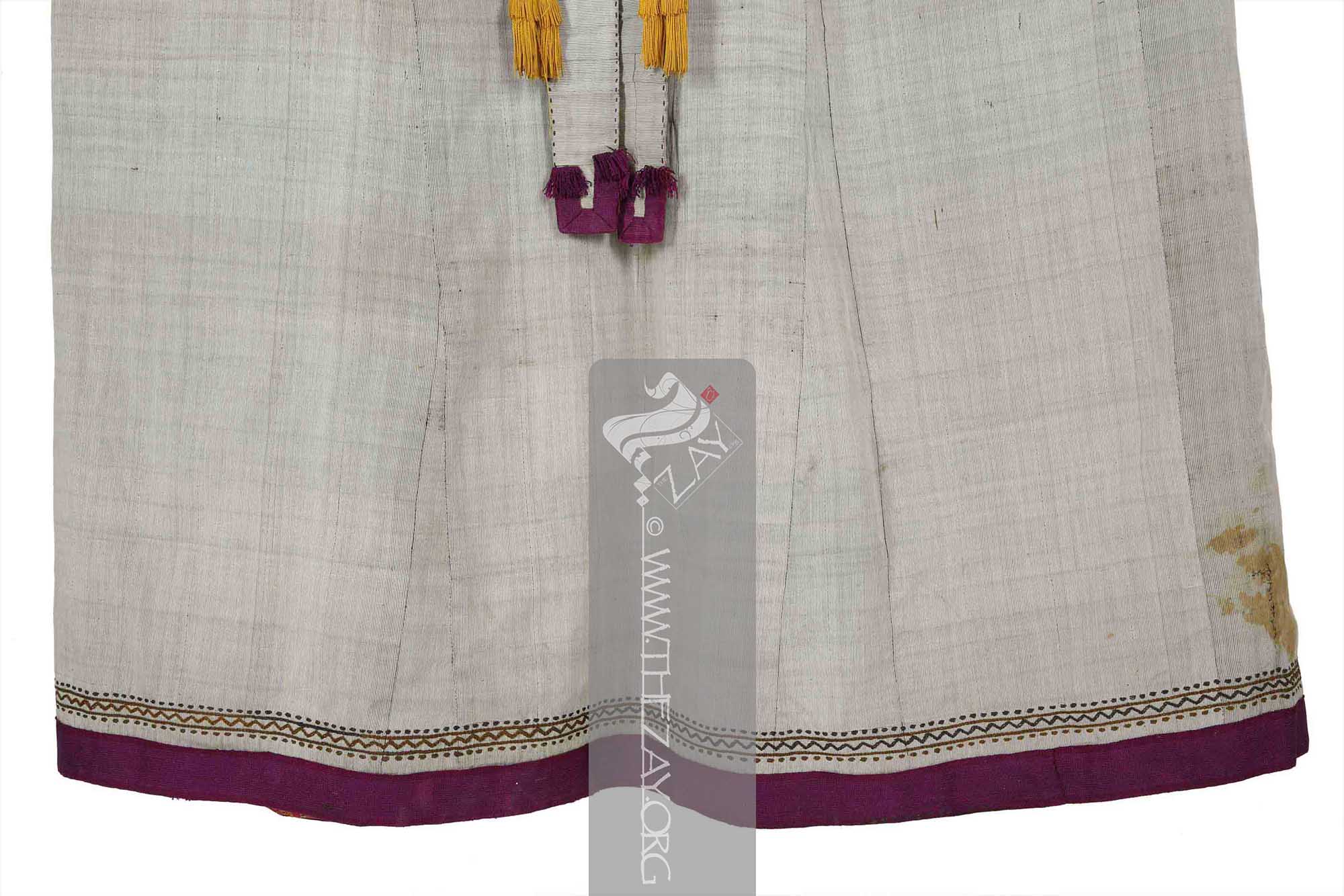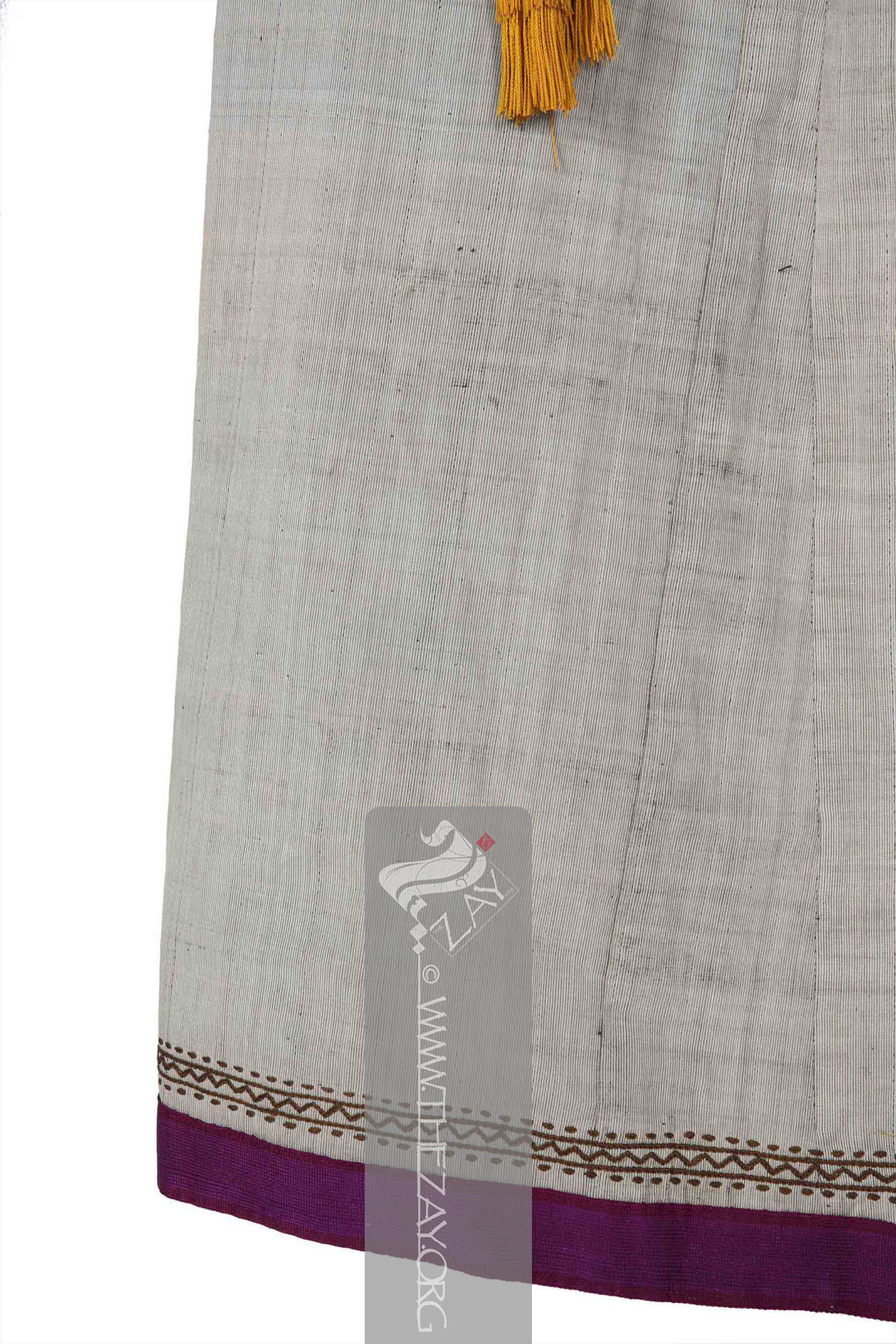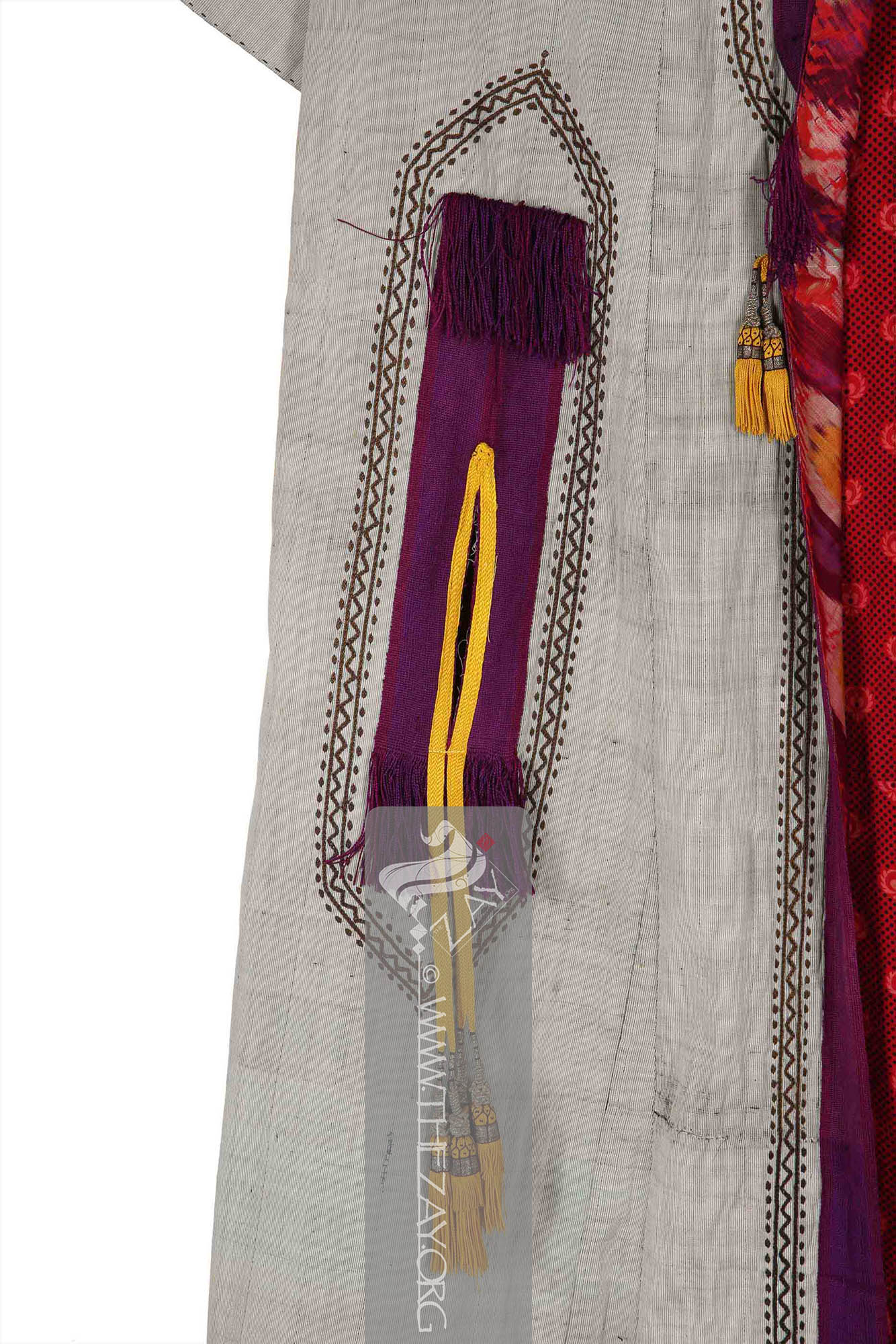Object HistoryThis grey silk Central Asian (
paranja
Paranja: (Synonym: Faranji, Purenjek
Purenjek: (Synonym: Paranja, Faranji, Chyrpy), traditional outer over garment worn in public by women in Central Asia consisting of a jacket like cloak with false sleeves. It is draped over the head and covers the entire body, including the face, leaving only a small opening for the eyes. , Chyrpy), traditional outer over garment worn in public by women in Central Asia consisting of a jacket like cloak with false sleeves. It is draped over the head and covers the entire body, including the face, leaving only a small opening for the eyes. ) was purchased by
Dr. Reem Tariq
Ṭariq: (Arabic; Synonym: tulle_bi_talli
Tūlle_bi_tallī: (French: Tulle – a city in France where fine material for veil was first made; Turkish: tel – wire; Synonym: tariq; talli; badla; khus_dozi ), series of small metal knots made on a woven net ground as embellishment. The term is commonly used in the North African Arab region specifically in Egypt.
; talli; badla; khus_dozi ), series of small metal knots made on a woven net ground as embellishment. The term is commonly used in the Levant Arab region specifically in Lebanon.
El Mutwalli
Dr. Reem Tariq
Ṭariq: (Arabic; Synonym: tulle_bi_talli
Tūlle_bi_tallī: (French: Tulle – a city in France where fine material for veil was first made; Turkish: tel – wire; Synonym: tariq; talli; badla; khus_dozi ), series of small metal knots made on a woven net ground as embellishment. The term is commonly used in the North African Arab region specifically in Egypt.
; talli; badla; khus_dozi ), series of small metal knots made on a woven net ground as embellishment. The term is commonly used in the Levant Arab region specifically in Lebanon.
el Mutwallī: Founder (CEO) of the Zay
Zay: (Arabic: costume, Pl. azyaā’), a set of clothes in a style typical of a particular country or historical period. Initiative, a public figure, speaker and author. An expert curator and consultant in Islamic art and architecture, interior design, historic costume, and UAE heritage. from one of the antique stores in the Islamic market suq, known presently as The Blue Souk, at the emirate of Sharjah in the United Arab Emirates (UAE), in 1995. It was eventually added to The
Zay
Zay: (Arabic: costume, Pl. azyaā’), a set of clothes in a style typical of a particular country or historical period. Initiative collection.
Object Features This is a women’s cloak or
paranja
Paranja: (Synonym: Faranji, Purenjek
Purenjek: (Synonym: Paranja, Faranji, Chyrpy), traditional outer over garment worn in public by women in Central Asia consisting of a jacket like cloak with false sleeves. It is draped over the head and covers the entire body, including the face, leaving only a small opening for the eyes. , Chyrpy), traditional outer over garment worn in public by women in Central Asia consisting of a jacket like cloak with false sleeves. It is draped over the head and covers the entire body, including the face, leaving only a small opening for the eyes. traditionally worn throughout Central Asia especially the Karakalpakstan as well the lower reaches of the Amu Darya River around the Khorezm region. These robes are long with vestigial sleeves and are draped over the head in public underneath, a heavy horsehair veil.
Made of grey flat woven silk with (
suzani
Suzani: (Farsi: suzandozi : needlework, from Farsi: suzan: needle, dozi: embellishment), type of embroidered and decorative Central Asian tribal textile art usually on a cotton fabric, embroidered in both silk or cotton thread with primarily chain, satin, and buttonhole stitches as well as couching technique. ) embroidery around the edges in brown silk
floss
Floss: (Old French: flosche – nap of velvet), is a type of silk fibre obtained from the cocoons of wild silkworms. It is characterized by its long, fluffy fibers that are not tightly woven, making it ideal for use in various textile applications such as embroidery, lace-making, and sewing. threads it also features tassels in yellow and purple or twisted silk yarns (
quadrille
Quadrille: (Latin: quadrum – square) Quadrille fabric is a type of lightweight cotton or linen fabric, woven with a checked or plaid pattern in contrasting colours. It is commonly used for clothing, drapery, and upholstery.
). The hem of the piece including its collars and cuffs have borders that were woven separately and attached to it.
Braided yellow silk threads are stitched on the borders too as decorative elements along with silver foil tassels that are wrapped around cotton threads.
The lining is in two different fabrics. Traditionally, both the fabrics for the lining used to be in silk (
ikat
Ikat: (Indonesian and Malay: Chord, thread, bundle; Synonym: atlas, adras), is a resist dyeing technique that involves tying and dyeing yarns or threads before weaving, resulting in a distinct pattern. With strong traditions in Southeast Asia, Central Asia, the Indian subcontinent and Central America it probably originated independently around the world. ) but this piece has a silk
ikat
Ikat: (Indonesian and Malay: Chord, thread, bundle; Synonym: atlas, adras), is a resist dyeing technique that involves tying and dyeing yarns or threads before weaving, resulting in a distinct pattern. With strong traditions in Southeast Asia, Central Asia, the Indian subcontinent and Central America it probably originated independently around the world. lining only around the edges.
The inside is lined with black, red, and pink printed cotton with floral motif repeats possibly of Russian origin. Cotton until the 19th century was usually imported from India and was quite expensive. With Imperial Russia’s conquest of the last Khanate, Central Asia’s demand for cotton was met by the Russian textile industry, especially from the city of Ivanovo.
The piece is completely hand-stitched mostly in a quilted style which contributes to an additional layer of decorative elements, especially in the underside.
The vestigial sleeves are long and narrow and are stitched to the back of the robe with a similar purple and yellow braided and woven patch.
Traditionally,
paranja
Paranja: (Synonym: Faranji, Purenjek
Purenjek: (Synonym: Paranja, Faranji, Chyrpy), traditional outer over garment worn in public by women in Central Asia consisting of a jacket like cloak with false sleeves. It is draped over the head and covers the entire body, including the face, leaving only a small opening for the eyes. , Chyrpy), traditional outer over garment worn in public by women in Central Asia consisting of a jacket like cloak with false sleeves. It is draped over the head and covers the entire body, including the face, leaving only a small opening for the eyes. were worn by city dwellers possibly both men and women, however, interesting they do not appear at all in medieval miniatures or texts until the late 18th century. It appears that
paranja
Paranja: (Synonym: Faranji, Purenjek
Purenjek: (Synonym: Paranja, Faranji, Chyrpy), traditional outer over garment worn in public by women in Central Asia consisting of a jacket like cloak with false sleeves. It is draped over the head and covers the entire body, including the face, leaving only a small opening for the eyes. , Chyrpy), traditional outer over garment worn in public by women in Central Asia consisting of a jacket like cloak with false sleeves. It is draped over the head and covers the entire body, including the face, leaving only a small opening for the eyes. is a result of the gradual transitioning of long jackets with sleeves that were often draped over the shoulders.
Linkshttps://www.youtube.com/watch?v=AzYwTqTER9Y
- Valérie Bérinstain, Mary Hunt Kahlenberg, Zaira Mis, Marcel Mis. Asian Costumes and Textiles from the Bosphorus to Fujiyama: The Zaira and Marcel Mis Collection. California: Skira, 2001.
- Suleman, Fahmida. Textiles of the Middle East and Central Asia (British Museum) The Fabric of Life. London: Thames and Hudson, 2017.
- Embroidery from Afghanistan Fabric, folios. Sheila Paine. Washington: University of Washington Press, 2006.
- Sukhareva, Olʹga Aleksandrovna. Suzani
Suzani: (Farsi: suzandozi : needlework, from Farsi: suzan: needle, dozi: embellishment), type of embroidered and decorative Central Asian tribal textile art usually on a cotton fabric, embroidered in both silk or cotton thread with primarily chain, satin, and buttonhole stitches as well as couching technique. : Central Asian Decorative Embroidery. Samarkand: SMI Asia, 2013.
- https://rjohnhowe.wordpress.com/2009/03/25/christine-brown-on-uzbek-clothing-part-1-the-lecture/
- https://rjohnhowe.wordpress.com/2009/03/25/christine-brown-on-uzbek-clothing-part-2-material-in-the-room/
- https://unesdoc.unesco.org/ark:/48223/pf0000130205
- https://asiasociety.org/central-asia-political-history-19th-century-present
- https://referenceworks.brillonline.com/entries/encyclopaedia-iranica-online/clothing-COM_7759?lang=fr#COM-10186
- https://www.internationalwardrobe.com/lexicon-2/der-mantelchapan-in-usbekistan-2/
- https://www.internationalwardrobe.com/lexicon-2/der-mantelchapan-in-usbekistan-2/
- https://www.textile-forum-blog.org/2023/01/on-the-roads-of-samarkand-wonders-of-silk-and-gold/




